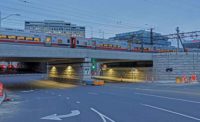ENR 2024 New England Best Projects
Best Project, Highway/Bridge: North Hero – Grand Isle Drawbridge Replacement

Photo courtesy HDR
North Hero – Grand Isle Drawbridge Replacement
North Hero to Grand Isle, Vt.
BEST PROJECT
Submitted by: HDR
Owner: Vermont Agency of Transportation
Lead Design Firm: HDR
General Contractor: Cianbro Corp.
The $75-million project restores the grandeur of Vermont’s only remaining movable bridge—a 60-year-old twin-leaf bascule structure that had exceeded its useful life. Carrying 3,000 vehicles per day across Lake Champlain’s Alburgh Passage during the offseason, and twice that volume during summer and fall, the bridge provides the sole road connection between the islands of North Hero and Grand Isle and provides a critical link south to the Vermont mainland.
Designed in collaboration with the local community and the state historic preservation office, the new crossing maintains the historic structure’s unique design while modernizing equipment and operations, improving safety and reducing maintenance, the project team says.

Photo courtesy HDR
Use of 3D and BIM tools helped optimize design for both constructibility and long-term management. A unique hydraulic cylinder lift system offers more redundancy with fewer components, while new walkways allow full access to the deck underside. A deeper superstructure and raised bridge profile provide additional headroom for workers.
Limited accessibility to the project’s remote location required extensive construction planning, including advanced concrete placement scheduling and limited maritime traffic disruptions. After determining that the original complex phasing plan to replace half the bridge at a time was unworkable, the team quickly pivoted to installation of an adjacent temporary drawbridge with 10 stationary approach spans. The temporary crossing capably accommodated motorists during multiyear demolition and construction and preserved boat traffic through the passage.

Photo courtesy HDR
Other challenges also demonstrated project team resilience and adaptability, such as discovery of soil contaminants that included printed circuit boards, hexavalent chromium and PCBs. Remediating the site delayed the project almost one full year and forced rapid redesign of a planned underwater control cable for the bridge into a wireless system.
To keep workers safe as construction continued through Vermont’s bitterly cold winters, the project team built warming huts and established requirements to avoid skin exposure. Workers spent no more than 30 minutes outside before being rotated back inside the huts.

Photo courtesy HDR
While the coronavirus pandemic complicated procurement of certain materials, the resulting closure of the U.S.-Canada border also substantially reduced maritime traffic and frequency of drawbridge openings.



